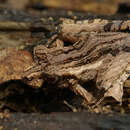Description
(
anglais
)
fourni par AmphibiaWeb articles
M 34-37 mm, F 32-39 mm. Dorsally less granular than G. asper and G. spinifer. Inner and outer dorsolateral ridges usually present. Small heel spines. Two often indistinct and longitudinal interocular tubercles. Colouration very variable. Males with blackish paired subgular vocal sacs (Glaw and Vences 2007).Taken with permission from Glaw and Vences (2007).
Raxworthy, C. and Vences, M. (2008). Gephyromantis ambohitra. In: IUCN 2008. 2008 IUCN Red List of Threatened Species. www.iucnredlist.org. Downloaded on 20 March 2009.
- auteur
- Miguel Vences
- auteur
- Frank Glaw
Distribution and Habitat
(
anglais
)
fourni par AmphibiaWeb articles
Manongarivo, Montagne d’Ambre (Glaw and Vences 2007). This species has been observed at an elevational range between 500-1200 m asl in pristine rainforest only (Raxworthy and Vences 2008).
- auteur
- Miguel Vences
- auteur
- Frank Glaw
Life History, Abundance, Activity, and Special Behaviors
(
anglais
)
fourni par AmphibiaWeb articles
Habits: Males call at night from bushes, 0.5-1.5 m above the ground, in or near rainforest, usually close to streams. Generalized free swimming tadpoles in small streams (Glaw and Vences 2007). Calls: A slow series of about 15 unharmonious notes (Glaw and Vences 2007).
- auteur
- Miguel Vences
- auteur
- Frank Glaw
Life History, Abundance, Activity, and Special Behaviors
(
anglais
)
fourni par AmphibiaWeb articles
This species is listed as vulnerable because its Extent of Occurrence is less than 20,000 km2, its distribution is severely fragmented, and there is continuing decline in the extent and quality of its forest habitat in northern Madagascar. It has a very fragmented distribution but occurs within several protected areas: the Parc National de Montagne d'Ambre, the Réserve Naturelle Intégrale du Tsaratanana, and the Réserve Spéciale de Manongarivo. A major threat is habitat loss, due to expanding subsistence agriculture, logging, charcoal manufacture, increased grazing, invasion and spread of eucalyptus, and expanding human settlement (Raxworthy and Vences 2008).
- auteur
- Miguel Vences
- auteur
- Frank Glaw
Gephyromantis ambohitra: Brief Summary
(
anglais
)
fourni par wikipedia EN
Gephyromantis ambohitra, commonly known as the Montagne d'Ambre Madagascar frog, is a species of frog in the family Mantellidae. It is endemic to Madagascar. Its natural habitats are subtropical or tropical moist lowland forests and subtropical or tropical moist montane forests. It is threatened by habitat loss.
- licence
- cc-by-sa-3.0
- droit d’auteur
- Wikipedia authors and editors

